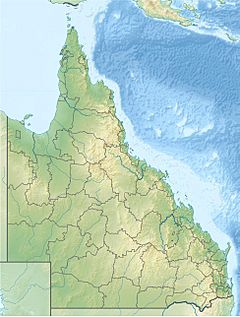Jeannie River facts for kids
Quick facts for kids Jeannie |
|
|---|---|
|
Location of Jeannie river mouth in Queensland
|
|
| Country | Australia |
| State | Queensland |
| Region | Far North Queensland, Cape York Peninsula |
| Physical characteristics | |
| Main source | Great Dividing Range northwest of Hope Vale and west of Starke 230 m (750 ft) 14°54′31″S 144°46′12″E / 14.90861°S 144.77000°E |
| River mouth | Coral Sea adjacent to Howick Island 0 m (0 ft) 14°39′30″S 144°55′26″E / 14.65833°S 144.92389°E |
| Length | 43 km (27 mi) |
| Basin features | |
| Basin size | 3,638 km2 (1,405 sq mi) |
| National park | Cape Melville National Park |
The Jeannie River is a natural waterway located in Far North Queensland, Australia. It flows through the northern part of the Cape York Peninsula, which is a beautiful and mostly untouched area. This river is an important part of the local environment and supports many different plants and animals.
Contents
Where the Jeannie River Flows
The Jeannie River begins in the Great Dividing Range. This mountain range is located in the northern part of the Cape York Peninsula. The river's starting point is northwest of a town called Hope Vale and west of Starke.
Journey to the Sea
From its source, the Jeannie River flows mainly towards the northeast. It travels through quiet, uninhabited areas. Along its journey, it passes by a place known as Lagoon Prospect.
The river then enters the Cape Melville National Park. This park is a protected area, meaning it's kept safe for nature. Finally, the Jeannie River empties into the Coral Sea. Its mouth is very close to Howick Island.
River's Drop
As the Jeannie River flows for about 43-kilometre (27 mi) (27 miles), it drops a total of 230 metres (750 ft) (755 feet) in elevation. This means it flows from a higher point down to sea level.
River's Catchment Area
The Jeannie River has a large catchment area of 3,638 square kilometres (1,405 sq mi). A catchment area is all the land where rain and other water collect and flow into a river. Think of it like a giant funnel that gathers water for the river.
Wild Rivers and Wetlands
This catchment area includes the "wild rivers" of the Jeannie, Howick, and Starke. "Wild rivers" are waterways that are largely untouched by human development. They flow freely and naturally, without many dams or changes.
Within this area, about 175 square kilometres (68 sq mi) (68 square miles) are made up of estuarine wetlands. Estuarine wetlands are special areas where fresh river water mixes with salty ocean water. These places are very important for many types of fish, birds, and other wildlife. They act like nurseries for young animals and provide a rich habitat.


